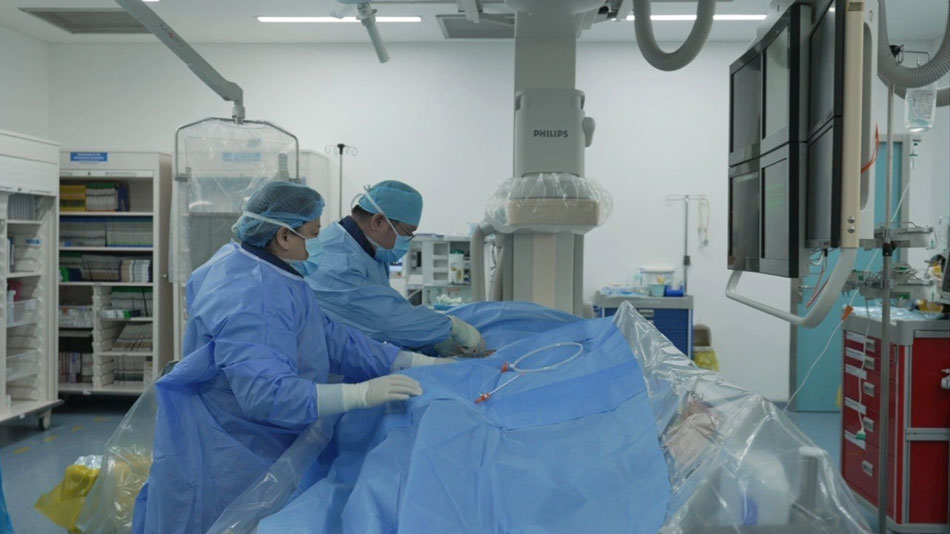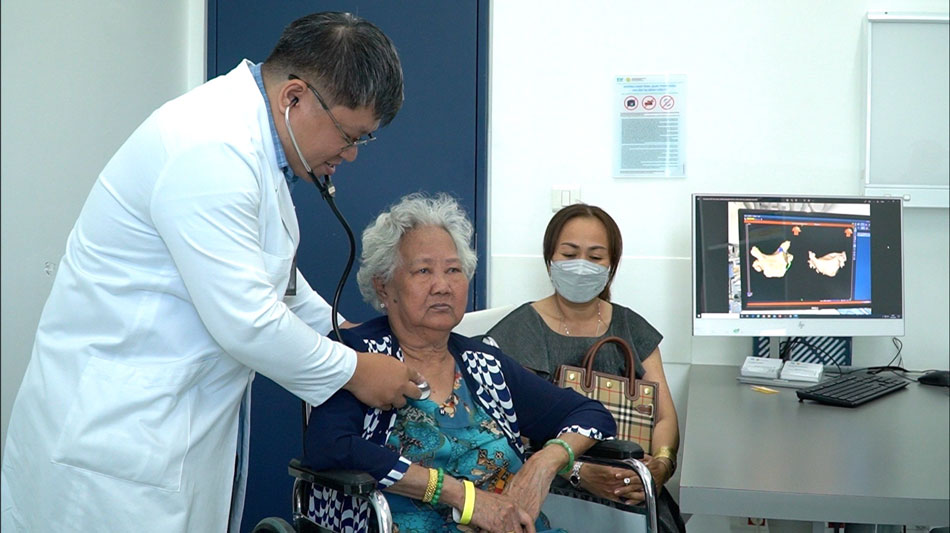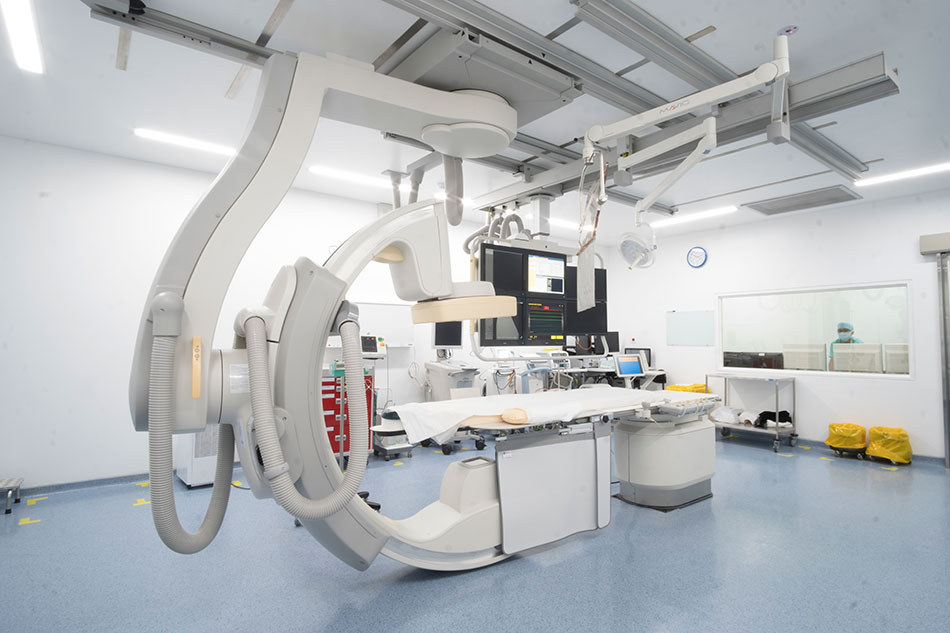Mrs Tran Thi Ho (79 years old, Ho Chi Minh City) was admitted to FV Hospital experiencing difficulty breathing and a pounding in her chest, accompanied by a rapid heartbeat. FV doctors diagnosed her with atrial fibrillation and performed radio frequency ablation to restore her heart rhythm to normal.
Treatment of atrial fibrillation via radio frequency ablation
Despite her advanced years, Mrs Ho is discharged in good health one day after atrial fibrillation ablation.
Dr Hoang Quang Minh, Cardiology Department at FV Hospital, recalls that Mrs Ho, an elderly patient, was brought to FV Hospital’s Accident & Emergency Department in a state of severe respiratory distress. She also had underlying conditions of liver fibrosis and high blood pressure. An electrocardiogram revealed that she was experiencing atrial fibrillation, a type of cardiac arrhythmia characterised by rapid and irregular contractions of the atria. Immediately, Dr Minh managed the atrial fibrillation with medication and then controlled the underlying risk factors contributing to the condition.

FV’s Cardiology doctors perform a Radio Frequency Ablation procedure
As the patient’s health gradually stabilised, doctors proposed the next treatment plan: radio frequency ablation. The patient underwent a comprehensive health assessment, and doctors developed a treatment strategy to ensure safety at each step before performing the ablation procedure. In addition to the risk factors associated with Mrs Ho’s advanced age, frailty, and high blood pressure, her liver fibrosis posed a challenge as it could potentially lead to blood clotting disorders that would be difficult to control.
The radio frequency ablation procedure for Mrs Ho lasted nearly four hours, with Dr Minh dedicating a significant portion of the time to perform a crucial task: creating a 3D electro-anatomical map of her heart chambers to determine the position of the four pulmonary veins. Using a combination of high-frequency wave ablation and physiological cardiac stimulation, the team placed catheters in the pulmonary vein area to isolate the electrical activity causing atrial fibrillation.

Dr Hoang Quang Minh conducts a follow-up examination for Mrs Tran Thi Ho.
After undergoing the procedure, Mrs Tran Thi Ho was monitored for one day before being discharged. During her follow-up examination in early June, the results showed that she no longer had any cardiac arrhythmias. “Previously, I would often feel exhausted, losing my breath after just a few steps. My children had to rush to support me for fear that I would collapse. Since the surgery, I have become healthier, able to walk independently, and no longer feel fatigued while moving,” shared Mrs Ho.
Atrial fibrillation increases the risk of stroke 500%
Dr Hoang Quang Minh explains that the heart has four chambers, including two atria and two ventricles. In order for the heart to function properly, blood flows from the atria to the ventricles, then out to nourish the body, and travels to the lungs for oxygen exchange before returning to the heart to continue the circulatory cycle. In a healthy body, the activity of the atria is smooth and synchronised with the ventricles. However, in some instances, the regularity of the atrial activity is disrupted, leading to atrial fibrillation.

Dr Hoang Quang Minh, Cardiology, FV Hospital, provides consultation to a patient regarding atrial fibrillation treatment.
Atrial fibrillation is a relatively common condition, estimated to affect around 37 million people worldwide—a 33 per cent increase of cases from 20 years ago. It is projected that by 2050, the number of cases of atrial fibrillation could exceed 60 per cent. Dr Minh advises that when individuals experience palpitations, chest pounding, shortness of breath, or fatigue, they should seek medical attention so that their condition can be accurately diagnosed.
The most common risk factors for atrial fibrillation are related to the heart, such as high blood pressure, heart failure, coronary artery disease; inflammation, such as thyroid disorders, thyroid gland diseases, gastroesophageal reflux disease, diabetes; and non-cardiac causes, such as sleep apnoea, obesity, smoking, chronic obstructive pulmonary disease.
Individuals with atrial fibrillation have a fivefold higher risk of stroke compared to those without the condition. Additionally, the increased frequency of atrial fibrillation episodes can affect the mechanical function of the atria, cause atrial chamber enlargement, and alter the structural shape of the atria, leading to an increased risk of heart failure.
Treatment methods for atrial fibrillation
According to Dr Hoang Quang Minh, using anti-arrhythmic medications to control atrial fibrillation has a success rate of around 20 to 40 per cent. If medication is ineffective, doctors may consider treating the patient with high-frequency wave ablation.
The key aspect of atrial fibrillation ablation is that it requires a 3D cardiac mapping system. Currently, radio frequency ablation, under the guidance of a 3D system, is the preferred choice for treating atrial fibrillation and other cardiac arrhythmias. This modern interventional cardiology treatment method is advantageous as it can be performed quickly, without surgery or general anaesthesia, and has a complication rate of less than 1 per cent.

FV Hospital is equipped with a modern Cathlab facility, capable of performing complex cardiac interventions
Dr Minh further emphasises that atrial fibrillation ablation can only reduce the frequency of episodes and prevent the recurrence of atrial fibrillation in the long term. The key is for patients to control other risk factors contributing to atrial fibrillation by adopting a healthy lifestyle and undergoing regular health check-ups.
To find out more about atrial fibrillation, please contact FV Hospital at: (028) 5411 3333.



